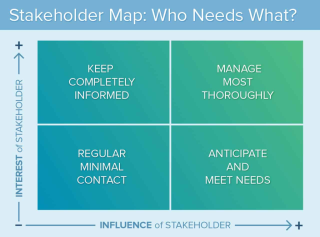How to Develop a Communications and Stakeholder Strategy for Effective Legal Project Management Scaling
You can have the best Legal Project Management strategy and team in the world, but without adoption they will have little impact on your firm's profitability or operations.
This week, we offer advice on mapping stakeholders and communicating for better adoption. As ever, this series is designed to be a practical guide so we will be sharing tips and tools gathered during our many webinars with LPM professionals.
Mapping your stakeholders
The first step in any collaborative process should be in mapping your stakeholders. For many firms, this process is too superficial. Stakeholder mapping should go beyond simply identifying the partners or customers that you wish to support. Instead, true stakeholder mapping is about identifying and evaluating the relative importance of all stakeholders in the LPM process. Consider making this exercise visual, by identifying stakeholder groups and the key players within them. These groups should include (but are not limited to):
- Client value, pricing or other internal non-practicing lawyers
- Practicing lawyers
- Decision makers & C-suite executives
- Clients
- Service providers
- IT and other support staff
Communicating directly with each and every one of these stakeholders is obviously unrealistic. This is where the evaluation of your stakeholders comes into play. Plotting individual stakeholders against a matrix of influence and interest is a way to quickly identify key players.
Those with the highest influence and the highest interest can be brought on side as project champions. Those with a lot of influence, but perhaps less interest (or even downright negativity) should be more carefully supported by the communications process.
Lines of communication
Having mapped your stakeholders (and hopefully identified your project champions), it is important to identify which stakeholders need access to which information. Each stakeholder has different requirements and the more targeted your communication, the more effective it will be.
One of the simpler ways to develop these communication 'lines' is, again, to map them out. Begin with a simple table, covering the following data:
Stakeholder group: Practice group managers
Key players: Jane Doe, John Doe
Frequency of communication: Monthly
Type of information needed: Success stories, Intervention metrics, How-to guides, LPM trainings
Channels for communication: Internal newsletter, Monthly meetings
Each of these lines becomes a communication strategy in and of itself. In this way there is clarity surrounding what is being communicated, to whom, and through which channels.
The golden rules of communication
Change is not something that comes naturally and it takes a considerable effort to motivate new behavior. Following an extensive number of webinars with LPM professionals we have identified three golden communication rules that ensure greater adoption:
- They can't use it if they don't know it exists
- Choices increase adoption
- Use cases should match stakeholders
The content and delivery method of each communications plan is obviously unique. However, these rules are frequently cited as forming the cornerstones of successful scaling efforts. As such they should govern what and how you communicate with your stakeholders. Let's dive into them in turn.
Spreading the word
It is important to note that most communication must be proactive. As many LPM teams will be aware, it is rare for someone to look actively for a service if they do not know that it exists. First, try to automate interventions by LPM teams where possible. At client intake, consider automatically sending a notification to the LPM team if the matter exceeds a financial threshold. This reduces the communication burden and ensures LPM are always alerted to high value matters.
Next, think critically about the existing communications channels which each stakeholder group uses. Instead of trying to make a new one (we've all got enough newsletters in our inbox) identify the ways they already collect information. Does a specific stakeholder group already have a monthly meeting? Do clients already use HighQ or is there a practice group retreat coming up? For Elizabeth Satterfield, Director of Pricing and LPM at Proskauer, the most effective communication method has been collaborating with existing training programmes for junior associates, and new partners.
Finally, consider restructuring the LPM team itself. Stephen Allen, an LPM veteran, noted that communication is vastly improved where LPMs are broken down along practice group lines. Where a smaller, dedicated LPM team works directly with each practice group there is greater integration and the LPM team is kept in the loop about the matters at hand and the challenges the practice group faces. This leads to better insights about how and what to communicate for best adoption.
How technology supports choice
Different matters require different LPM interventions. For some matters, reporting on budget will be sufficient. For others, clients want to closely integrate their own project managers with the firms to develop holistic matter management. Internally, these 'flavors' of LPM intervention should be communicated in a targeted way. After all, understanding that there is a choice rather than a one-size-fits-all is likely to motivate greater adoption.
Try mapping stakeholders on an axis of interest against importance. Partners who manage important or high value matters, but who are not interested in LPM could be targeted with soft-touch matter reports. Partners with a motivation to use LPM and high value matters should be given detailed information about LPM services. Furthermore, tracking which stakeholders make use of which services can help refine your communication strategy in the long term. Does a specific practice group only ever make use of LPM reporting services? Why is that? Can you communicate more effectively to increase adoption?
Choice is equally important for clients and decision makers. Some clients will prioritize transparency and will value being presented with choices about the level of LPM reporting and intervention. The same goes for decision makers. Some will want detailed, data filled reports and others more strategic insights. Tailor each communication strategy to the choices made by your stakeholders.
At this point it is important to note that technology can reduce much of the communication burden felt by LPM teams. Tools like Clocktimizer can generate and share tailored reports at regular intervals. Consider developing specific reports (an Excel spreadsheet is a great place to start if you haven't progressed to business intelligence platforms) which are shared at set intervals with specific stakeholder groups.
Use cases are unique
The final golden rule for communication is about matching use cases with stakeholders. As we mentioned earlier, each stakeholder will have a different set of challenges in keeping matters on track and to budget. As such, use cases should be matched to these problems.
In practice, sharing success stories is a simple way of communicating how a specific LPM intervention solved a specific problem. On the opposite end of the spectrum, James Barrett of Eversheds Sutherland makes use of 'war stories'. Partners share insights into how and why matters went wrong through a lack of LPM intervention. Either way, capitalizing on real life use cases, shared by the partners themselves, is an effective communication strategy.
Once again, data from matters can also help identify problems that stakeholders themselves may not be aware of. Clocktimizer enables analysis of matters along practice group, matter type or even seniority lines. Identifying particularly un-profitable activities or matter types, and the ways LPM can address them, is an effective communication tool in and of itself. After all, the majority of stakeholders do not have the level of insight necessary to identify how and why their matters are running off course. Having clear data on the problem and the solution reduces the arguments against adoption.
In our final installment
Having covered the process, the technology and now communication, our final installment sees us tackle the matter lifecycle itself. What does a good matter lifecycle look like, from pricing to matter intake, to the project management itself, to post mortem analysis? Should you have one unified process, or a different approach for different practice groups? What tools can support the process and what advice do our network of experts have?



